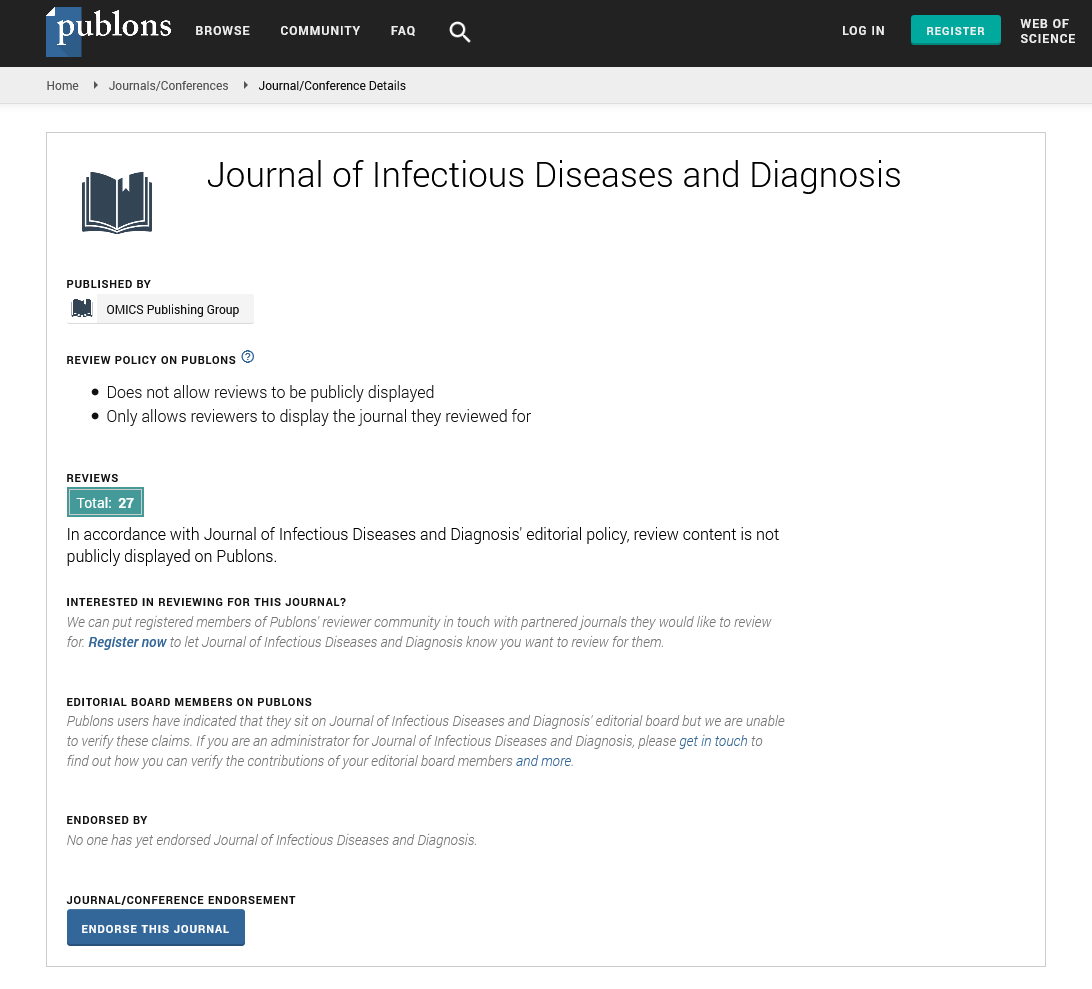Indexed In
- RefSeek
- Hamdard University
- EBSCO A-Z
- Publons
- Euro Pub
- Google Scholar
Useful Links
Share This Page
Journal Flyer

Open Access Journals
- Agri and Aquaculture
- Biochemistry
- Bioinformatics & Systems Biology
- Business & Management
- Chemistry
- Clinical Sciences
- Engineering
- Food & Nutrition
- General Science
- Genetics & Molecular Biology
- Immunology & Microbiology
- Medical Sciences
- Neuroscience & Psychology
- Nursing & Health Care
- Pharmaceutical Sciences
Perspective - (2025) Volume 10, Issue 5
Current Perspectives on the Identification and Management of Gastrointestinal Infections
Daniel Whitman*Received: 29-Aug-2025, Manuscript No. JIDD-25-30294; Editor assigned: 01-Sep-2025, Pre QC No. JIDD-25-30294 (PQ); Reviewed: 15-Sep-2025, QC No. JIDD-25-30294; Revised: 22-Sep-2025, Manuscript No. JIDD-25-30294 (R); Published: 30-Sep-2025, DOI: 10.35248/2576-389X.25.10.353
Description
Stomach infections are a common health concern that can affect people of all ages. They often result from the ingestion of contaminated food or water, exposure to infected individuals or contact with unsanitary surfaces. The symptoms of these infections vary in severity and duration, ranging from mild discomfort to serious illness that requires medical attention. Individuals may experience nausea, vomiting, Diarrhea, abdominal cramps, fever and general fatigue. Occasionally, dehydration can develop due to fluid loss, which is particularly concerning for young children, older adults and those with compromised immune systems. Understanding the causes and methods of diagnosis is essential for managing these conditions effectively.
Clinical evaluation usually begins with a detailed assessment of symptoms and recent exposures. Physicians often inquire about recent meals, travel history, contact with sick individuals and any medications or underlying medical conditions. Such information can help narrow down the possible causes of the infection and guide decisions regarding testing and treatment. Although symptoms alone provide important clues, they are not sufficient to determine the exact cause of the infection, as multiple organisms can produce similar clinical presentations. Laboratory testing is typically necessary to confirm the diagnosis and identify the responsible agent.
Stool analysis is one of the primary methods used to detect the presence of bacteria, viruses or parasites in cases of stomach infection. Bacterial cultures can identify pathogens such as Salmonella, Escherichia coli, Shigella and Campylobacter. These tests involve cultivating samples in specialized media under controlled conditions, allowing accurate identification of the organism. While cultures are reliable, they require several days to produce results, which can delay targeted treatment. In response to this limitation, molecular techniques such as Polymerase Chain Reaction (PCR) are increasingly used for rapid and precise detection. PCR identifies the genetic material of specific pathogens and can distinguish between different strains, which is particularly valuable for tracking outbreaks and guiding treatment strategies.
Rapid antigen or toxin detection tests are available in some clinical settings to provide quicker preliminary results. These tests identify proteins or toxins produced by pathogens and can inform early decisions regarding patient care. However, they are generally less sensitive than molecular methods and may produce false negatives, necessitating confirmatory testing. Serological tests, which detect antibodies produced by the immune system in response to infection, are sometimes used to evaluate previous exposure or assess immunity. Although less useful for immediate diagnosis, serology contributes to understanding the broader impact of infections within a community.
Emerging diagnostic tools are designed to improve the speed and convenience of detection. Point-of-care devices, portable immunoassays and biosensors have been developed to allow testing in settings without fully equipped laboratories. These technologies can provide results within hours, reducing delays in treatment and containment. In addition, they are particularly valuable in areas with limited healthcare infrastructure, where rapid identification can prevent widespread transmission.
Effective diagnosis also depends on careful observation of clinical signs. Monitoring hydration status, vital signs and the severity of gastrointestinal symptoms helps determine the urgency of intervention. Patients with severe dehydration, persistent vomiting or high fever may require hospitalization for intravenous fluids and close monitoring. In less severe cases, supportive care, including oral rehydration solutions and dietary adjustments, can effectively manage symptoms until the infection resolves. Antibiotic therapy may be necessary if a bacterial infection is confirmed and is deemed likely to benefit the patient. Overuse of antibiotics is discouraged, as it can lead to resistance and other complications.
Despite advances in detection, challenges remain in diagnosing stomach infections accurately and efficiently. The wide variety of potential pathogens, variability in symptom onset and differences in individual immune responses can complicate clinical assessment. Laboratory testing requires careful sample collection, handling and processing to ensure reliable results. Access to testing facilities and timely reporting are additional factors that influence effective diagnosis and treatment. Continuous improvement in diagnostic methods and coordinated public health efforts are necessary to address these challenges.
In conclusion, stomach infections are common yet complex conditions that demand careful evaluation, accurate testing and timely intervention. Clinical assessment, combined with laboratory analysis through culture, molecular methods, rapid tests and serology, provides a comprehensive approach to identifying the causative agent. Emerging technologies and point-of-care diagnostics are expanding access to faster testing, supporting better patient management and reducing the risk of transmission. Maintaining awareness of symptoms, practicing good hygiene and adhering to safe food and water practices remain essential strategies for prevention and control. Effective diagnosis and management of stomach infections benefit not only individual patients but also contribute to overall community health by limiting the spread of infectious agents.
Citation: Whitman D (2025). Current Perspectives on the Identification and Management of Gastrointestinal Infections. J Infect Dis Diagn. 10:353.
Copyright: © 2025 Whitman D. This is an open-access article distributed under the terms of the Creative Commons Attribution License, which permits unrestricted use, distribution and reproduction in any medium, provided the original author and source are credited.

